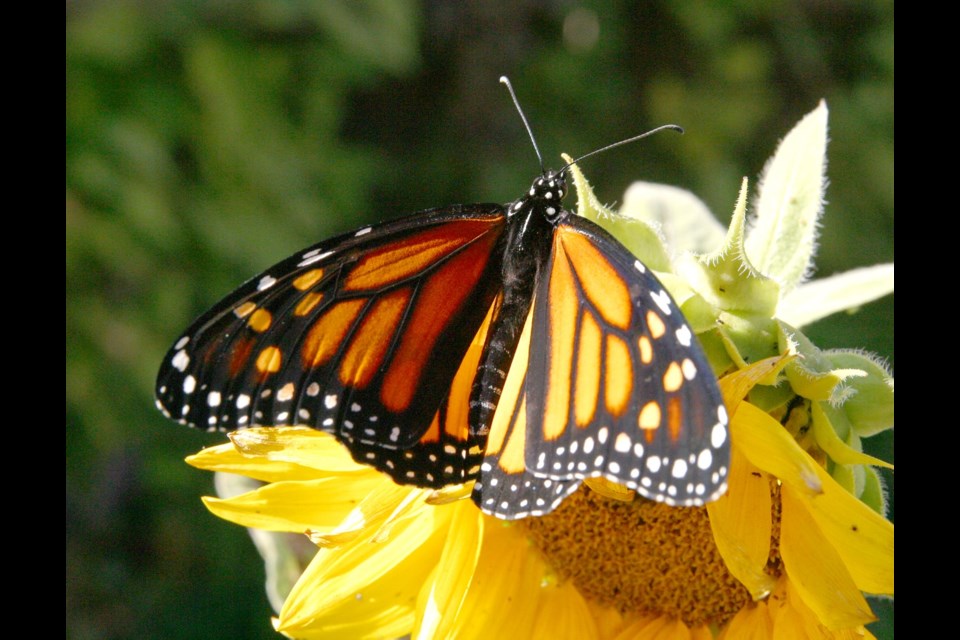REGINA — An enigmatic species with bold orange and black eye-catching colour, it’s no wonder so many people are enamoured with the monarch butterfly.
With the species recently being uplisted from special concern to endangered, this iconic migratory butterfly could use our help in supporting its recovery more than ever. But when does our help become a hindrance? Many suggestions on how to help the Monarch that are gaining popularity can hurt our wild population. Here are the do’s and don’ts if you are looking to help.
Captive rearing is popular with butterfly enthusiasts, not only because you get a close-up view of the butterflies’ life cycle, but also because it is something tangible when it comes time to release the adults and you watch them fly away.
“While these projects can foster a love for the species, we encourage people to choose a different way to help,” Emily Putz, habitat stewardship co-ordinator with Nature Saskatchewan states.
“Rearing butterflies together though often comes with significant risk to both the individual butterflies and your local population.”
The proximity can quickly spread disease, such as the bacterial infection known as the black death or the parasitic Ophryocycstis elektroscirrha (OE) disease. Butterflies with OE can appear fine at release and then spread this disease to wild butterflies or their offspring when in the wild; causing wing deformities and leading to death.
As well, captive-reared butterfly sources can be a problem. Butterflies that are ordered are often not from the local population, introducing genetics that is unfavourable to survive and potentially supporting poaching from wild populations for profit. When these individuals are released in areas north of the species’ range, or at a time that doesn’t align with their natural hatch, the chance of them making a successful migration to their wintering grounds in Mexico decreases.
Not all monarch populations migrate, which can further affect genetics if they are from populations that do not. Eggs and larvae taken from roadside ditches or other natural areas may also seem like an action that helps vulnerable individuals make it to adulthood, but problems can persist in the rearing conditions.
“It is best to let nature be nature in a natural setting to give our monarchs the strongest chance,” Putz concludes.
To support monarchs, one of the best things to do is to get involved in responsible community science projects! Planting your own Milkweed patch to support habitat is a great way to rear butterflies naturally and support the population. Observing them in this setting and reporting your findings can further support recovery actions as more information is gained on their life cycle on the prairies. Projects like these are part of a bigger effort, joining together data and observations from your whole community towards a larger goal.
When looking to the species of Milkweed that are best, always go for native Milkweed species; of which Saskatchewan has five, several of which can be found readily available at greenhouses and nurseries. Broad-leaved species, such as Showy, Common, or Dwarf Milkweed, are the top choices for our monarchs, as they provide ample real estate for eggs and caterpillar food. Stay away from exotic Milkweed species, especially Tropical Milkweed. While attractive and flashy in its bright yellow, red, and orange hues, it hurts our monarchs. A warm climate species, it blooms much longer than our native varieties, tricking monarchs into delaying their life cycle until it’s too late to migrate. It can also spread OE and other diseases into a population with no defence.
Along with planting Milkweed, it is always encouraged to plant nectaring habitat species as well! The best of which are our native flowering species. Not only will a native garden provide food for monarch adults from Spring right through to Fall, but it also supports several other native pollinators; which in turn will help your garden grow more vibrant year after year!
Lastly, if you are a landholder within the monarch’s range, the number one way to help is by supporting natural habitat on your property! Allowing Milkweed and nectaring wildflower species on margin lands of crop and road ditches, delaying mowing of these areas until after the first generation of monarchs emerges, and supporting Milkweed patches within pasture and rangeland can go a long way to helping this species recover.
Looking for more ways to help? Report all monarch sightings to our Stewards of Saskatchewan community science program! If you are a landholder with a native milkweed patch that monarchs frequent, get involved in our Milkweed Monitoring as well! Every participant helps fill the gaps on our prairie population and how they use our Native milkweed habitat. Questions on the best way to help monarchs, or to report your sightings, please contact Nature Saskatchewan’s toll-free HOOTline, 1-800-667-HOOT (4668) or email Emily Putz at [email protected]. Every sighting helps with tracking the population and range of this iconic butterfly. All caller and program participant information is kept confidential.




